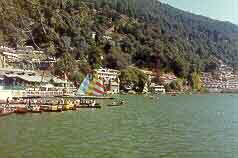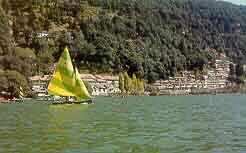|
Travelogues Nainital: Lap of Nature
|
|||||||||||||||||
After days of endless waiting and speculation, finally the day of departure dawned. Friends and colleagues had stayed overnight with me since I live close to the office from where we had to start at daybreak. With friends around, sleep is always an unwanted intruder, and the night was spent in the anticipatory excitement of escape from the crazy city life of Delhi.
|
More on Uttaranchal • Overview • Mussorie • Haridwar Travelogues • Kumaon Remembered
Impressions Trekking • Pilgrim's Trail | ||||||||||||||||
We went to Mall Road, which encircles the Naini Lake at the heart of the town, and is dotted by numerous shops, many of them selling decorative candles for souvenirs. We queued for the joy-ride on the famous rope-way, that carried us to Snow-view peak, high up in the mountains from where the view of the valley and the town spread in its lap, is breathtakingly beautiful. The surrounding thick fog made visibility poor. We tramped around awhile, and relaxed with a refreshing cup of tea at the garden restaurant. Returning below, we went boating in the Naini Lake. In the twilight, the moon was as beautiful as you could possibly want it to be. The boat slowly eased out into the lake and the rhythmic lapping of the oars against the water's surface held us spellbound. The air was light, cool and refreshing, and yet it sent an occasional chilly shiver down one's spine. The sound of silence was deafening; its spell broken only by the melodious humming of a Kumaoni tune by our boatman. The lake was larger than I had expected, and our hour's ride had quickly trickled by. On one side the imposing hill rose steeply, like a gigantic sentinel on guard. The other bank was dotted with numerous lights from endless shops, as if in festive celebration. The moon seemingly smiled down at us and nobody, save the boatman, wanted the ride to come to end. The air was now distinctly chillier, and the brisk walk on Mall road thawed our numb limbs. Returning to the hotel we sang around the bonfire warmed by the bonhomie of shared moments.
Standing there, it seemed I was redefining life's meaning for me. The Himalayas were beckoning me. To come and explore the thrills and mysteries hidden in them, to break the shackles of materialism. To look beyond the constricted world of my cubicle and unfurl the delights of nature. My reverie was broken by the "chai-wallah" and a cup of tea that tasted the best in years. Two timeless hours later, we returned to the hotel, and onto the hue and cry of Delhi. As the bus once again set in motion, I left something of me behind forever in the lap of nature.
|
|||||||||||||||||
Editor: Romola Butalia (c) India Travelogue. All rights reserved. |
|||||||||||||||||
 "Clikety-Clak...Clikety-Clak...!", goes the endless sound of mindless keyboards, the telephone forever shrieking in agony, the garrulous paging system always urging somebody to grab the nearest phone or make a dash to the reception. Life is an endless sojourn at this software development centre of a global giant. An announcement of a company sponsored trip to Nainital, seemed to have come straight from the Messiah.
"Clikety-Clak...Clikety-Clak...!", goes the endless sound of mindless keyboards, the telephone forever shrieking in agony, the garrulous paging system always urging somebody to grab the nearest phone or make a dash to the reception. Life is an endless sojourn at this software development centre of a global giant. An announcement of a company sponsored trip to Nainital, seemed to have come straight from the Messiah.

 The sun was far up in the sky, and the cool, fresh mountain air seemed like heaven's nectar after the poisonous air of Delhi, and I wanted to savour every drop of it. The ride was rendered thrilling by the antics of our driver who, with unbridled enthusiasm, accosted the hair-pin bends with speed and dexterity. The endless valleys, green with lush foliage, bathed in the exuberance of the cool, winter sun was a delight to our city-bred eyes. We checked in at hotel Manu-Maharani to enjoy a relaxed bath and lunch, before setting out to explore the beauties of nature that Nainital had in store for us.
The sun was far up in the sky, and the cool, fresh mountain air seemed like heaven's nectar after the poisonous air of Delhi, and I wanted to savour every drop of it. The ride was rendered thrilling by the antics of our driver who, with unbridled enthusiasm, accosted the hair-pin bends with speed and dexterity. The endless valleys, green with lush foliage, bathed in the exuberance of the cool, winter sun was a delight to our city-bred eyes. We checked in at hotel Manu-Maharani to enjoy a relaxed bath and lunch, before setting out to explore the beauties of nature that Nainital had in store for us.